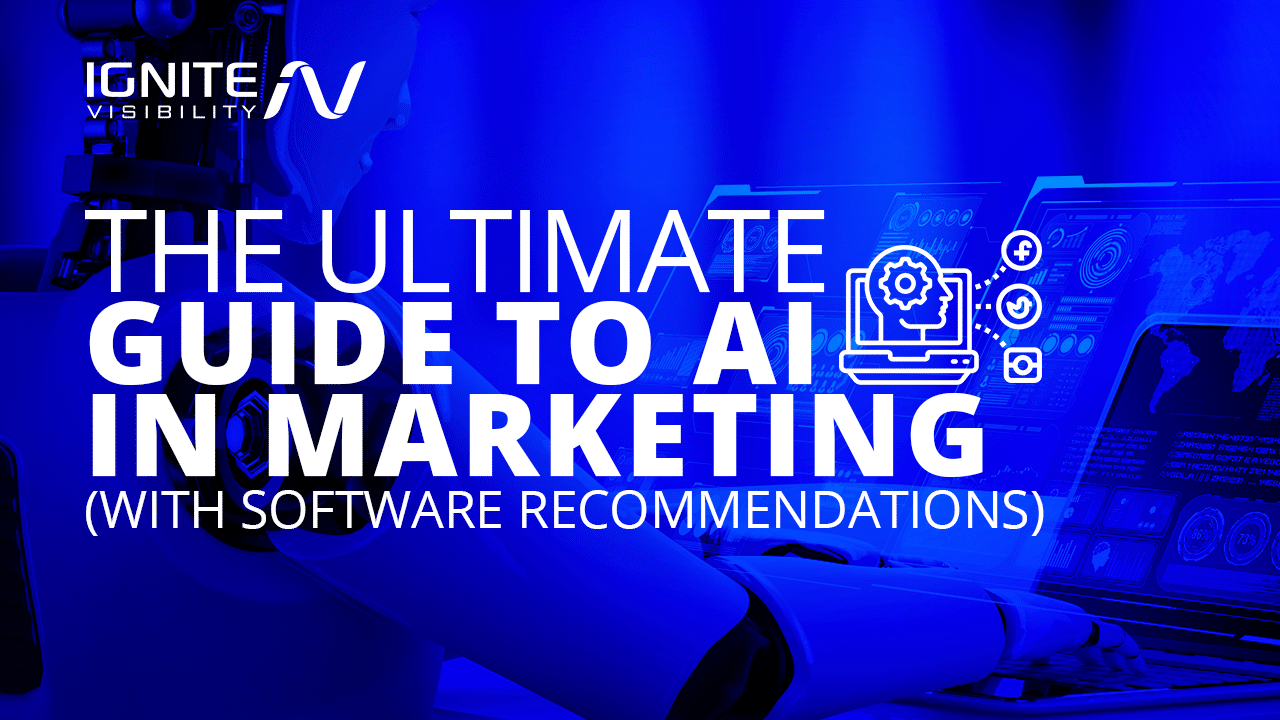
AI helps brands scale their marketing without sacrificing quality. These tools make marketing smarter, more efficient, and more comprehensive with minimal investment.
So in this article, you’ll learn everything about AI in marketing and 12 proven strategies for applying it to your strategy effectively.
What is AI?
Artificial intelligence is technology that simulates human intelligence. In marketing, this means making automatic decisions based on data, evaluation, and careful tracking of larger trends.
How Does It Work?
AI works by integrating large data sets with fast, continuous processing models.
This lets it recognize patterns or features automatically. And after each round of data processing, it tests and measures its own performance to gain additional insights.
In other words, AI analyzes tons of data constantly to find patterns. These patterns can be speech, fingerprints, KPIs, or anything else.
Because it never needs to take a break, it can constantly test these patterns and refine its output. This lets it learn a massive amount in a short time.
Four Types of AI in Marketing
You can categorize marketing AI based on two different criteria:
- Intelligence grade (does it just automate simple tasks or does it “think?”)
- Stand-alone vs. part of a larger system (integrated)
Combining these two, you get four main types of AI:
Stand-Alone Task Automation
Stand-alone task automation tools are isolated (i.e. not part of a system) programs that handle basic tasks. They’re tools in and of themselves—built to perform specific tasks efficiently.
For instance, Hunter offers email verification as part of its task automation portfolio. It pings an email list you supply it with for valid addresses, making a time-consuming task much easier.
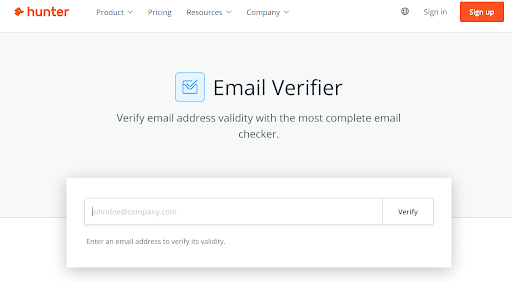
Integrated Task Automation
Integrated task automation AI exists within larger platforms. It performs basic tasks as part of a larger toolset.
For example, Trello lets users set tasks to move or archive automatically.
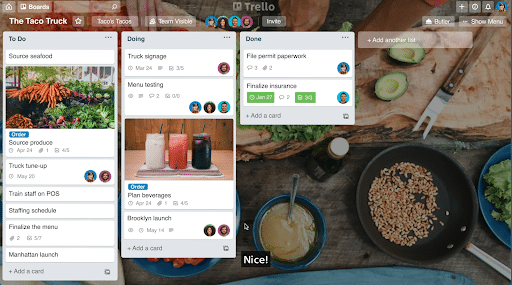
Another example is scheduling emails in Gmail.
Stand-Alone Machine Learning
Stand-alone machine learning apps use massive amounts of data to perform a certain complex task efficiently.
OpenAI trained DALL-E 2 on a massive amount of images to produce its own illustrations based on certain inputs. Since this is its only function, it’s a powerful example of a stand-alone machine learning tool.
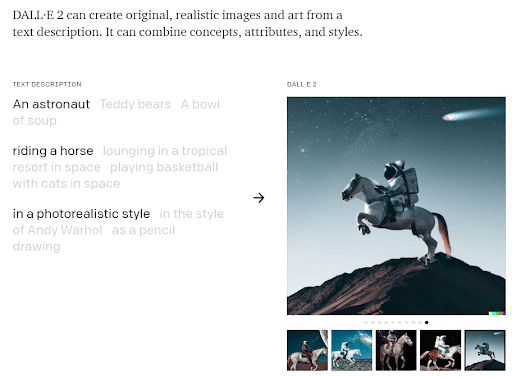
Integrated Machine Learning
Integrated machine learning AI uses its deep learning abilities to enhance certain experiences in a larger setting. When Netflix recommends suspiciously accurate shows for your next binge, you’re experiencing an integrated machine-learning tool.
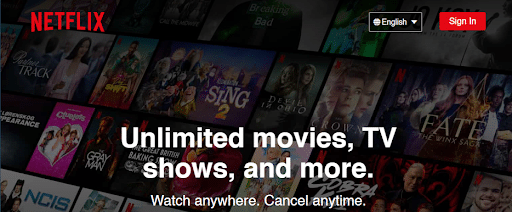
Challenges & Limitations of AI in Marketing
Artificial intelligence is effective for marketing, but it has a few limitations:
- Interoperability: Because AI is designed for its native system, it can be hard to integrate into new environments.
- Implementation Timeframe: AI is difficult to create due to its natural complexity.
- Privacy: Machine learning models need tons of data, so your firm may have to collect more information than consumers are comfortable with.
But these limitations don’t undermine AI’s massive benefits.
Benefits to Incorporating AI in Your Marketing Strategy
43% of marketers think automation and AI have been the most effective trends for growing their business. It has extensive applications for:
- Advertising: AI can test ads before publishing, provide detailed data, lower costs, and boost conversions.
- Analysis: Machine learning can spot patterns humans can’t because it studies data constantly.
- Social Media: AI can tell you what works from your best-performing content. It listens to conversations across social networks, telling you what customers say about your brand.
However, they’re only as effective as their deployment. AI’s marketing potential will pay off only for brands correctly implement it into their strategy.
How to Use AI in Marketing
Next, we’ll discuss how to integrate AI into your marketing step-by-step. By the end, you’ll have a blueprint for scaling your influence to new heights.
1. Tear Down Software Silos
Many companies collect tons of data across all their software tools but never centralize it so the whole company can use it effectively.
For instance, marketing agencies often consist of teams that work on projects together but operate independently. This type of company can be a disaster when it’s poorly organized.
Imagine that every department creates invoices, data reports, content, and other resources using separate, unintegrated systems. This leads to double entries, buying two different tools for the same thing, and other inefficiencies—all eating into billable hours.
There are two main solutions to siloed software:
- Integrating existing software manually
- Using AI-powered, all-in-one software
Function Point is an example of the second option. It centralizes every software function of agencies, tearing down siloes in CRM, financials, reporting, collaboration, and more.
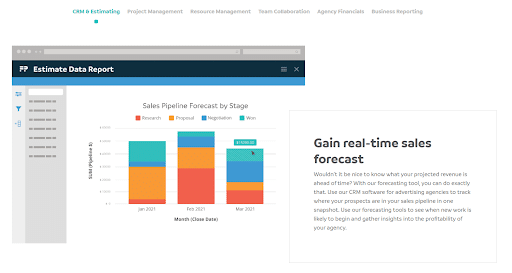
2. Personalization
Marketing inherently operates at scale. Even if you target a niche market, you’re still pitching your product to hundreds of different people and companies, all with unique qualities.
Addressing these diverse needs means tailoring your message to each prospect. But reaching a large audience makes personalizing all outreach too time-consuming.
AI solves this by automating personalization. It can customize email, push notifications, DMs, segmentation and more based on your input and consumer data.
One of the most relevant examples of AI personalization is email. Marketers use tools like Bloomreach to create personalized campaigns using segmentation
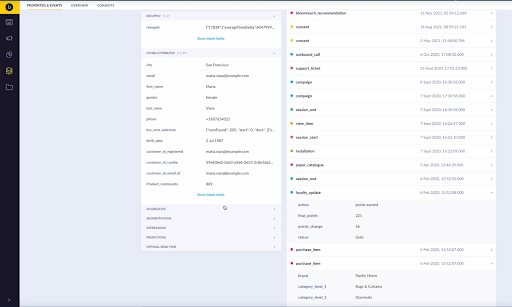
The result is hyper-personalized marketing, with AI leveraging all data available to tweak emails exactly to the recipient’s liking.
Marketing Personalization Software
Kibo
Kibo uses analytics AI to segment customers based on their behavior. Machine learning then optimizes messaging, content, and page layouts based on what fits their activity best.
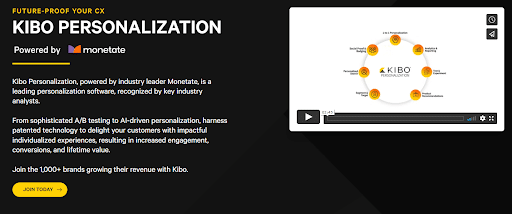
Instapage
Instapage dynamically shifts landing pages to display different information based on prospects’ personal data. This data can be geographics, traffic sources, or other attributes.
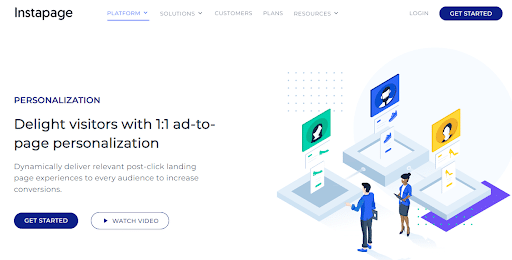
3. Smarter Chatbots
AI chatbots let businesses offer visitors 24/7 support without using humans. These AI chatbots go beyond scripted questions by using machine learning to produce human-like responses.
They have endless uses in marketing, like driving conversions, providing support, and arranging calls.
AI Chatbot Software
Zendesk
Zendesk combines chatbots with omnichannel support to provide data-driven service. Its AI recognizes user information (area, activity, purchase history, etc.) to provide tailored responses.
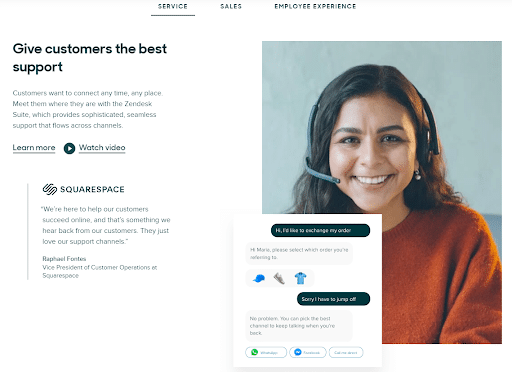
Intercom
Intercom creates customer service software, including highly advanced chatbots, as part of its portfolio. Their bots quickly gather lead information from customers, so your brand can score them easily.
Their bots even replace web forms, giving users a dynamic experience instead of a slow fill-out process.
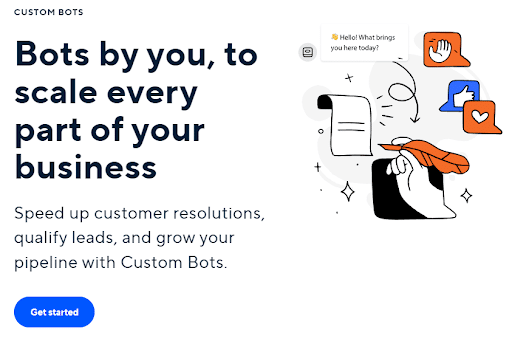
4. Informed Marketing Automation
Marketing automation is AI-powered software automating repetitive marketing tasks like social posting and PPC bidding. The most comprehensive automation tools—like HubSpot—include CRM for highly personalized marketing outcomes.
Marketing automation tools make campaigns more effective while reducing the effort needed to run them. These benefits are why 58% of marketers spend at least 10 hours per week using them.
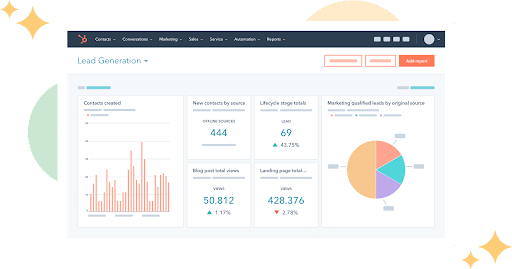
Marketing Automation Software
ActiveCampaign
ActiveCampaign streamlines a massive range of marketing work. You can use AI and third-party integrations to make every part of your marketing more efficient.
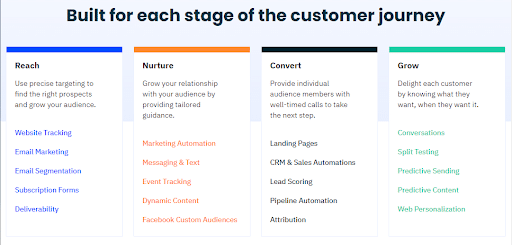
Klaviyo
With over 200 integrations, Klaviyo scans an enormous amount of data to provide personalized chatting experiences with visitors. It collects customer data right away, including:
- Contact channels (live chat, SMS, etc.)
- Coupons
- Order history
- Location and timezone
- Purchases and other engagement
Using this information it creates a customer profile to use for ultra-personal interactions.
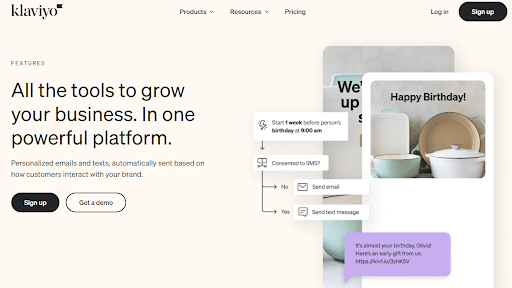
5. Social Listening
Social listening is watching social platforms for conversations about your brand.
When someone mentions your brand, you can respond directly (answer questions, handle complaints, etc.) or analyze it for insights. Social listening also monitors other relevant data, like hashtags, industry trends, and competitor mentions.
Modern social platforms host countless conversations. So social listening relies on AI to constantly watch for brand mentions.
For example, Hootsuite tracks millions of live conversations for mentions of your brand. It then combines this data into a visualization for in-depth analysis.

Social Listening Software
Sprout Social
Sprout Social monitors, Twitter, Facebook, Instagram, and several other networks for brand mentions. Combined with dozens of integrations, Sprout lets you gain deeper insights from your customers.
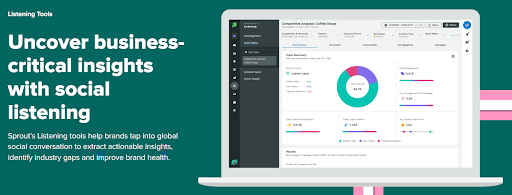
Brandwatch
Brandwatch identifies and summarizes key trends around your business in an easy-to-read dashboard. It not only watches for text mentions but products and logos sharing too.
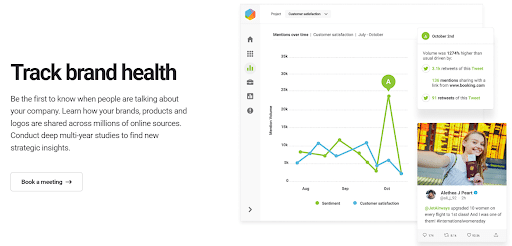
6. Dynamic Product Pricing
Dynamic pricing is when prices are dynamic, changing based on certain factors. It’s about selling the same thing at different prices to different people.
This isn’t to be confused with price discrimination—the unethical practice of changing prices based on customer identity. Dynamic pricing adjust prices according to supply and demand, location, competition, and other objective factors.
Let’s say you’re booking a last-minute flight to Chicago and use an app to track prices. To ticket starts at $250 but drops to $200 a few hours later.
This is dynamic pricing at work. Because the airline had trouble filling the last few seats, its software dropped the price to get watchers to buy.
Dynamic pricing maximizes sales by operating at different price points. AI optimizes prices by studying industry trends, price surges, and more.
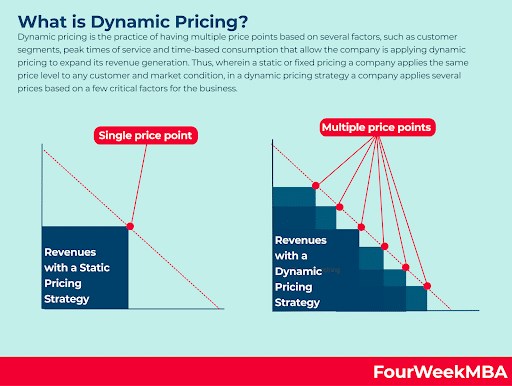
Dynamic Pricing Tools
Prisync
Prisync gives you an optimal price tag based on several factors according to your needs. For instance, it might reduce product’s pricing based on competition but always increase when supplies run low to keep it in stock.
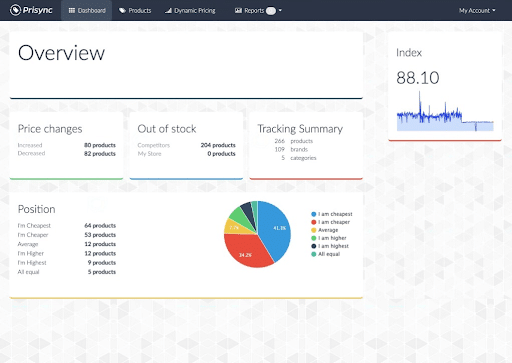
netRivals
netRival’s repricing AI recommends pricepoints based on cost-per-acquisition (CPA), competitors, plus your average price and availability. You can even set prices to increase when competitors run out of stock.
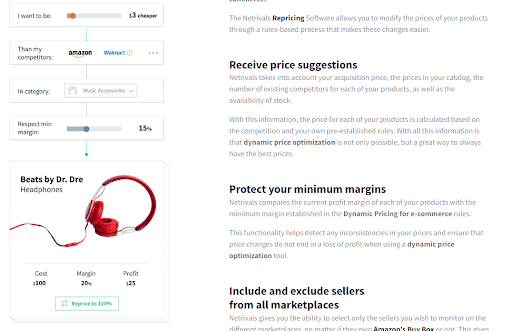
7. Speech Recognition & Voice Search
Speech recognition software uses artificial intelligence, machine learning, and natural language processing to convert speech into readable text accurately. Its main use is text-to-speech transcription, but it has marketing applications as well.
For instance, consumers use Amazon Alexa and Google Home stations to make searches purely by voice. These voice search tool then fetch quality results from the internet and read them back to the user.
To appear in voice search results, marketers should strive to get the featured snippet on Google. This is the text box that often appears before a search’s first ranking page (for this reason, SEOs often call it “position zero”).
Speech recognition also plays a vital role in optimizing customer experience.
When customers call your company, speech AI can transcript the calls. They can also detect shifts in tone, providing valuable insight into how well your brand serves customers.
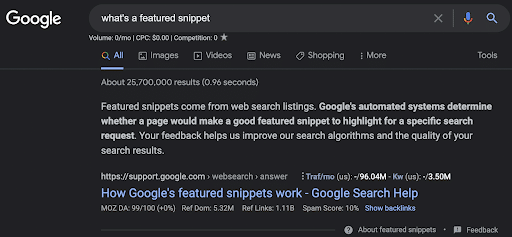
Voice Recognition Software
Amazon Transcribe
Amazon Transcribe is world-renowned for its high accuracy and ease of use.
It converts large batches of input into easily-readable transcripts. These transcripts also include timestamps, punctuation, and labels for different speakers.
Deepgram
NASA, Spotify, Citi, and other renowned organizations use Deepgram to transcribe over 30 languages into over 100 file types. Deepgram also offers software development kits (SDKs) to build custom apps using its technology.
And if you’re skeptical, you can demo Deepgram’s transcription AI live on its own page.
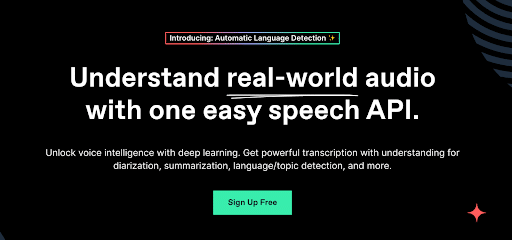
8. Programmatic Advertising
Programmatic advertising serves ads to consumers with optimal pricing and timing. Compare this to manual ad placements, which require constant effort to optimize.
Programmatic advertising takes the guesswork out of media buying, outsourcing hours of crunch work to AI. Ad buying tools automate the entire process for you based on your goals, audience data, and KPIs.
These tools are so effective since they work directly with ad buyers and sellers at the same time.
When an advertiser wants to promote their product, they use a demand-side platform (DSP) to automate the buying process. This DSP works with multiple publishers to find the best opportunities across each.
And when someone wants to sell ad space on their website, they use a supply-side platform (SSP). This SSP maximizes the value for each impression served by leveraging AI like DSPs do.
Programmatic Advertising Software
SmartyAds
SmartyAds is a programmatic advertising tool designed for all aspects of advertising. It offers:
- A supply-side platform for sellers
- A demand-side platform for buyers
- Whitelabeling for agencies and ad exchanges
It also supports all media formats (video, display, etc.) across all devices (desktop, mobile, and TV).
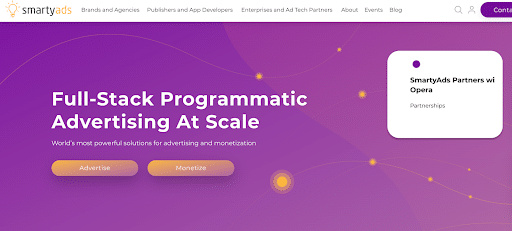
Simpli.fi
Simpli.fi is another comprehensive ad automation tool offering both SSP and DSP platforms. Advertisers can use in-depth consumer data (location, browser, device, etc.) to build highly-optimized campaigns.
Simpli.fi also offers dozens of data reporting templates for simple, in-depth performance analysis.
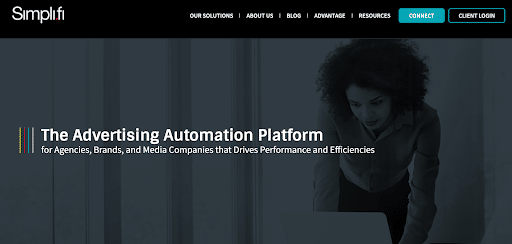
9. Predictive Analysis
Predictive analysis (AKA “predictive analytics”) predicts future marketing trends by analyzing past data. This helps leaders secure the long-term success of their brands with informed decisions.
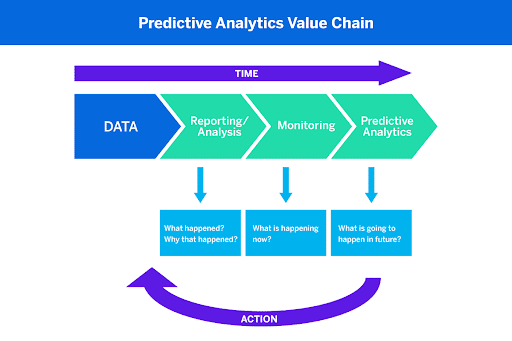
Examples of predictive analysis include:
- Audience segmentation
- Lead scoring
- Finding optimal demographics to target with ads
- Personalizing customer experiences based on segmentation
Predictive AI scans millions of data sets to find patterns humans never could on their own. The result is more informed decision-making across all marketing channels.
Predictive Analysis Software
Alteryx
Alteryx makes it easy to translates massive amounts of data into marketing discoveries. Using machine learning, it builds detailed predictive models and converts them into data reports.
It’s also entirely code-free, making it accessible to all skill levels.
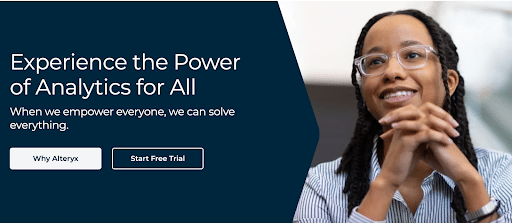
SAS
SAS uses cutting-edge machine learning to cut the guesswork out of your marketing. Its platform uses advanced algorithms to identify intricate patterns within your data.
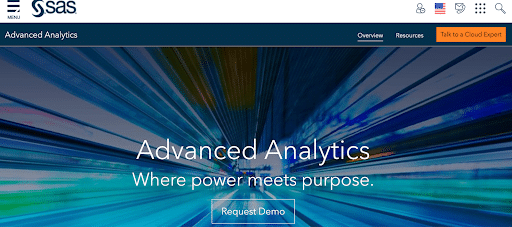
10. A/B Testing
A/B testing is when you run different versions of a campaign to see which performs best with your audience. One half of your audience sees version A, while the other half sees version B.
A/B testing is vital for understanding how audiences feel about your ads. As you no doubt understand, consumer behavior can be radically different from what you expect.
Let’s say you wanted to test two versions of your CTA:
- “Learn more” (Your existing CTA)
- “Download now” (One you think will perform better)
To test these CTAs, send both versions of your ad to a small audience with only that one change. The version that performs best in your KPIs (e.g., downloads) wins.
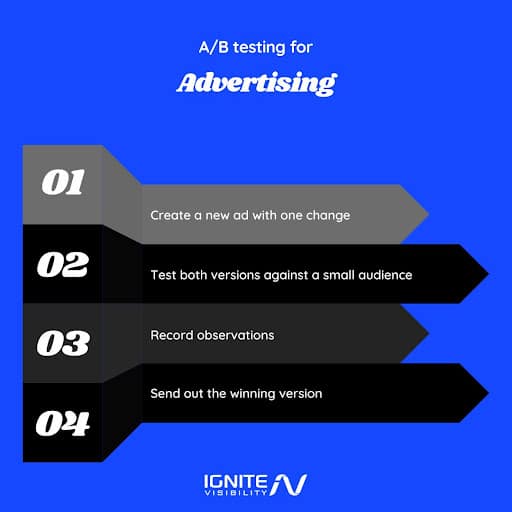
11. Lead Scoring
Ever began a free trial only to get multiple calls from a sales team afterward? You probably thought, “They’re wasting their time—I was only slightly curious about their product.”
You know as a consumer that not every lead is equal. Sales teams who call every trial signup waste valuable resources on leads who likely won’t convert.
The solution to this inefficiency is lead scoring. Lead scoring lets your brand prioritize leads effectively based on their potential.
It works by assigning a value to each lead, usually in the form of points. You base these off of user data and behavior—info submitted, pages visited, etc.
When you have a system for assigning value for each lead, your sales team can focus on those most likely to convert.
Giving love to the prospects most likely to buy greatly increases your conversion rate. Some leads are highly interested in your product, but need help to move forward.
How AI Enhances Lead Scoring
AI automates the massive workload that large-scale leadscoring requires. Using machine learning, it creates a precise list of qualified leads based on behavior data.
Software like 6sense use a trillions-strong interaction database to determine the buyer intent behind every user action. The result is a constant stream of opportunities for your sales team to convert potential customers.
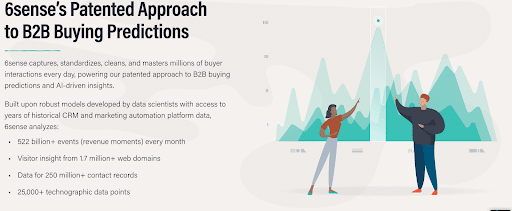
12. Detect Trends
No matter your industry, getting to new ideas first is everything. AI uses machine learning to find relationships between consumers and new ideas across the web.
Exploding Topics is a SaaS selling this trending data by itself. It uses sophisticated algorithms to locate trends across the web and sends them to subscribers to use for marketing.
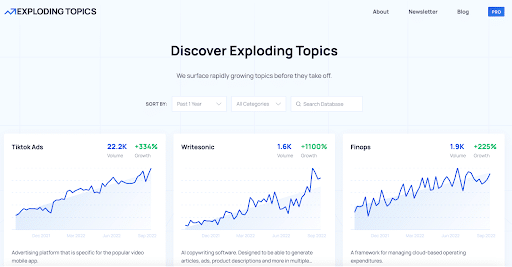
Other services let you use AI to find trends yourself, like Trend Hunter. Marketers use their service to get industry insights based on millions of consumer interactions.
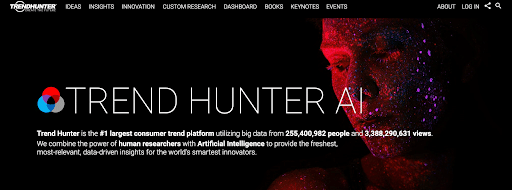
AI is Vital for Effective Marketing
AI doesn’t just enhance modern marketing—it enables it.
Your team can’t study millions of interactions daily to find emerging trends. They don’t have time to analyze the specific behavior of your leads, either.
AI automates all this, letting marketers operate more effectively than they could otherwise. It’s just a matter of taking advantage of it before your competitors do.